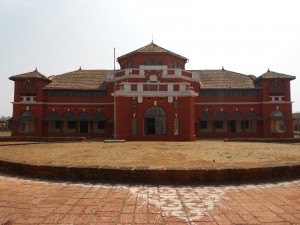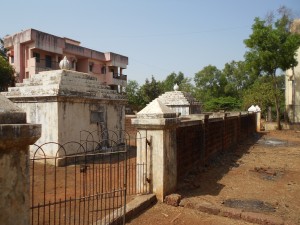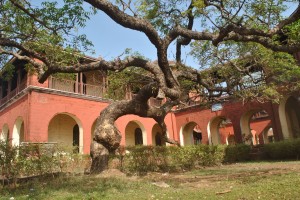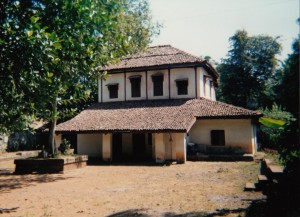Dear Dr. Amitav Ghosh,
I presume you must be getting a lot of fan mail, my mail is no different.
Ever since I got hold of The Hungry Tide (while on a visit to Calcutta), I have been reading your books. I’ve not read all your books but I’m reading them in intervals, else I would have read them all.
I was so enamored and griped while reading The Glass Palace, that I took off , the next weekend to Ratnagiri from Bombay. I had, vaguely known that King Thibaw was exiled to Ratnagiri by one of my friends from Assam, many many years ago. But the catalyst was your wonderful book. I was driven to seek out the story for myself.
I looked up the Kings descendents Chadrakant Pawar (Chandu),
chatted with him and his family, to get to know a bit more of this forgotten tale, visited the Palace
and also the royal tombs.
What a joy to experience all this right from your book.
I thank you for this interesting journey. After my visit, a clearer picture emerged of the story. But I was saddened by the plight of the Kings descendents, there was nothing in it for them, being of blue blood, such is life.
If you have the time, please have a look at some of the photos of my Ratnagiri visit.
I very very eagerly await more and more books from you. 2012 will be dedicated to reading all your books, which now very few remain unread.

My name is Gauraang and I work for the Economic and Political Weekly in the commercial section. You had published an article in the EPW sometime back.
Best
Gauraang
_____________________________________________
Dear Gaurang
Thanks so much for this generous letter! It’s wonderful to know that the book inspired you to visit Ratnagiri. I really liked the town – did you visit BG Tilak’s birthplace?
It’s a beautiful Konkani house.
I should tell you though (but perhaps you already know this) that the King did not live in the present day ‘Thebaw Palace’ for long. He spent most of his time in Ratnagiri in Outram House, at the other end of town.
You’ll be glad to know that an excellent account of the Burmese royal family’s years in exile is soon to be published. It is by Sudha Shah – I am just reading the proofs. I will soon review it on my blog [posted on April 12].
Speaking of which, would you mind if I posted your letter on my blog? If you send me jpgs of some of your pictures I could post those too.
I am glad to know that you work at the EPW. It is an extraordinary publication – and Ram Reddy is an old friend of mine.
With my best wishes
Amitav
________________________________________________
Dear Dr. Amitav Ghosh,
What a delight to receive your email. It would be a privilege for me, to have my letter on your blog. I’m sending a few photos along with this mail.
No, I did not get a chance to see Tilak’s house, I will surely do so on my next visit. The time I went, was just with a singular purpose of finding anything about King Thibaw in Ratnagiri.
I did know, that the King did not spend much time in the present Thibaw Palace, but is not the present day Outram House, the residence of the District Collector, just a short distance from the Palace. There is even a “point” opposite the Collectors residence called Thibaw Point.
Thank you for informing me about Sudha Shah’s work on the Burmese royal family’s years in exile, I will be looking forward to that.
Many in India know about Bahadur Shah Zafar, being exiled to Rangoon, but very few know about the Burmese King being exiled to India. You might be surprised, in Assam, my friend tells me, King Thibaw’s exile was a chapter in their history syllabus.
Thank you once again for the wonderful books.
Regards,
Gauraang
_______________________________________







I’ve read your Glass Palace and other books, all very special books to me. It was a pleasant surprise to see the photos of the Burmese Kings family on your blog.
Thanking you.
Anand
Thank you for sharing this exchange, it is so illuminating in many ways.
Some years back, I was also reading something about the descendants of the last Mughal Emperor who were living in Hyderabad in circumstances not so well off. I also remember some stuff about Tipu Sultan’s descendants.
The British as colonial masters were in their own way ruthless in dealing with ‘native’ loyalty. Reduction to penury was some sort of humiliation, subtly delivered from above.
The Bolsheviks were brutal but their victims passed on to become elusive legends (if one can make some sort of macabre comparison). I was thinking in particular of the legend that surrounds Anastasia.
Stil it is a bit contradictory. Royalty no longer exists (In India) and it was all abolished as being reminiscent of more feudal and parasitic times and yet we (judging by how the media talks of the young nawab of Pataudi, for example) have this strange nostalgia as well.
The photographs capture the timelessness as well as the fleeting nature of all things, and thank you for sharing these with a wider audience.
Sincerely
Anu Kumar
Dear Dr. Amitav Ghosh,
I wonder that King Thibaw body was cremate or buried.
Sincerely
Sudhisak Palpho
General Sir James Outram, who took part in Indian mutiny 1857 is my daughter’s husband’s great grandfather. I have just read the Glass Palace I loved it and wondered whether Outram house was named after this reasonably famous General.I enjoyed your book because it gave such a fascinating other side of history. Is Outram house still in existence?
It’s not quite clear what happened to the house. I think it was torn down and a new one erected in its place in the 20s. But you can certainly still visit the site. There are many other sites associated with Gen Outram in India. Outram Ghat in Kolkata for example. You might also like to watch Satyajit Ray’s film ‘Shatranj ke Khilari’ where Richard Attenborough plays the part of James Outram.
all best
Amitav Ghosh
My daughter’s husband’s great grandfather was General Sir James Outram who participated in the Mutiny in 1857. I love.ed your book it was fascinating giving another dimension to history. Was Outram house named after this general who was reasonably well known and is the house still possible to visit?I look forward to reading more of your books.
There was also a statue of Outram on horse back in front of Fort William on Khidderpur road at Calcutta. Sometimes after independence this statue was moved like many other British Generals and Governors in some other place.
Further I would like to know about Sawant family to which the King’s elder daughter married.
You will find an extensive account of Sawant’s family in Sudha Shah’s book on the Burmese royal family. I also reviewed it on this site.
A
Dear Amitav,
Thibaw Palace at Ratnagiri was a local folklore. I am talking about time in late 80’s and 90’s growing up in India. The India so different from now.
Having lived in far flung suburbs of erstwhile Mumbai, visiting Konkan or Kokan beaches during summer vacations were nothing short of religious trips for us.
As a child i think i had heard from many of my Grandmas stories about Thibaw and her cursing of the Britishers.Naturally curiosity had set in .Those times of no internet it was a challenge to get any information about Burmese family other than far flung few snippets in news papers.And only thing known then was Tutu and her poverty and nothing more.Finally I think in 1992 or so during one of our trips i do recall we drove past the Thibaw palace and i forced my dad to stop the car and just stood at the gate and watched.Gates were locked and there was nothing nearby. As a child i was filled up with a number of thoughts, what would they do here? is this place not isolate? how can a king live in a brick building?? and how can they the british be so cruel ? how ? how? and naturally then me pestering my dad to go and find the kings relative in Ratnagiri town, an idea that was but naturally brushed aside politely.
I took up reading again this year after years of gap and was glad tochance upon GLASS PALACE and all those memories came flooding by. It was a beautiful narration countries, histories and personalities entwined togather. Enjoyed your well researched book. Shall grab others when i visit home.Cheers ( please do not post my email id). regards
Chaitanya